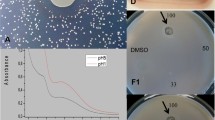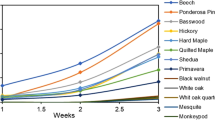Abstract
ALTHOUGH most wood-destroying fungi of the white- and brown-rot type may be differentiated by the Bavendamm test, which depends on the oxidative browning of tannic and gallic acid agar by fungi of the white-rot type, certain inconsistencies in this reaction have been noted by Davidson, Campbell and Blaisdell1. Recent investigations by me2 have shown that fungi of the brown-rot type, and certain species incapable of causing decay under laboratory conditions, also can produce a positive oxidase reaction on these substrates. These inconsistencies were not encountered when wood-meal first treated with ether and acetone to remove the phenolic substances was used as a substrate.
This is a preview of subscription content, access via your institution
Access options
Subscribe to this journal
Receive 51 print issues and online access
$199.00 per year
only $3.90 per issue
Buy this article
- Purchase on Springer Link
- Instant access to full article PDF
Prices may be subject to local taxes which are calculated during checkout
Similar content being viewed by others
References
Davidson, R. W., Campbell, W. A., and Blaisdell, D. J., J. Agric. Res., 57, 683 (1938).
Etheridge, D. E., Ph.D. thesis, University of London (1956).
Brauns, F. E., J. Amer. Chem. Soc., 61, 2120 (1939).
Author information
Authors and Affiliations
Rights and permissions
About this article
Cite this article
ETHERIDGE, D. Differentiation of White- and Brown-Rot Fungi by an Oxidase Reaction. Nature 179, 921–922 (1957). https://doi.org/10.1038/179921a0
Issue Date:
DOI: https://doi.org/10.1038/179921a0
This article is cited by
-
Étude Taxonomique De La Famille Des Polyporacées
Mycopathologia et Mycologia Applicata (1974)
-
Fluoreszenzmikrokopische Beobachtungen an pilzbefallenem Holz
Holz als Roh- und Werkstoff (1968)
-
A new polyphenoloxidase test for distinguishing between wood-rotting fungi
Biologia Plantarum (1967)
Comments
By submitting a comment you agree to abide by our Terms and Community Guidelines. If you find something abusive or that does not comply with our terms or guidelines please flag it as inappropriate.



